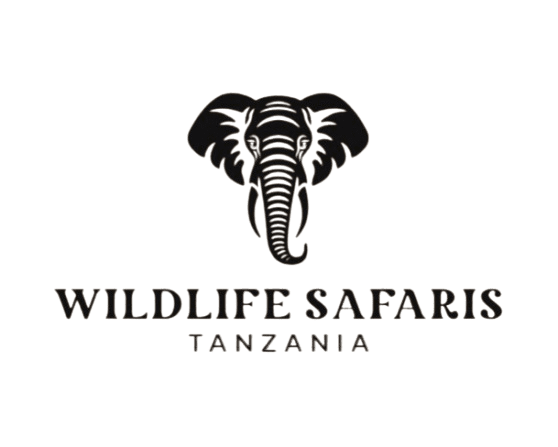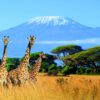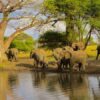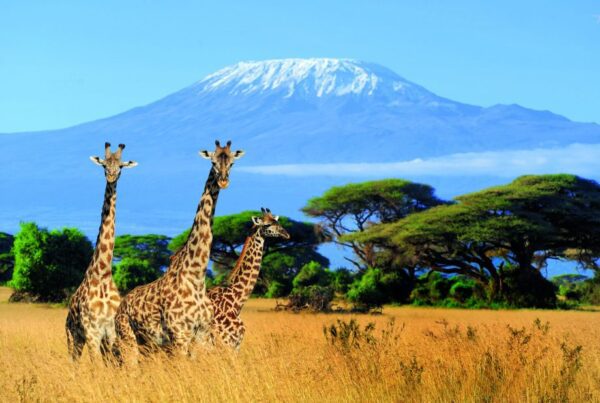2025: Ngorongoro Conservation Area, Africa’s Most Popular Tourist Destination.
The Ngorongoro Conservation Area was named Africa’s Leading Tourist Attraction 2025, continuing its winning streak from 2023. South Africa’s Table Mountain, the Hartbeespoort Aerial Cableway, Robben Island, and the V & A Waterfront were among the other top African attractions that the conservation area was crowned with. Lake Malawi in Malawi, the Pyramids of Giza in Egypt, the Okavango Delta in Botswana, and Mount Kilimanjaro in Tanzania were among the other contenders.
Voters were compelled to vote in favor of this stunning protected region, which was established in 1959 after being separated from the Serengeti, because of the impressive features it included. In addition to animals, it has hosted humans in the past and continues to do so now. We talk about the best parts of the park that voters (and you) could have loved. Persevere, for the final installment holds my attention.
Cerro Ngorongoro
The centerpiece of the protected area is this crater, which extends over 264 square kilometers. Visitors come to witness the abundant animals and savor the breathtaking scenery. The Big Five are among the more than 25,000 huge creatures that call this relatively little park home.
There are 70 lions in the crater, or one every 3.8 square kilometers. Additionally, it is an encouraging location to see black rhinos. Acacia bushes and shrubs provide cover for these massive creatures. Also, the Lerai Forest is a good place to see leopards.
Wildebeest, zebra, impala, and buffalo are some of the plains animals you could see on a floor drive. Foxes, jackals, mongooses, spotted hyenas, and cheetahs are among the predators that can be seen.
Popular Things to Do • Observing Wildlife • Watching the Sun Set
Plains of Ndutu
Huge grasslands in the Ndutu region stretch out in every direction. Together, they form the Serengeti’s southern half. Because there is no barrier separating the Serengeti and Ndutu, animals are free to go between the two protected regions as they choose.
The Great Migration passes over these plains from December through March, and even into April. In November, when rains begin to fall, the plains become verdant, drawing in gazelles, wildebeests, and zebras who are in a rush to give birth. These ungulates like to give birth here for a reason:
Nutritious grasses that are good for the calves’ development grow on Ndutu’s farm. The southeastern Serengeti plains and Ndutu were made productive by the volcanic ash that was blown to them from the Ngorongoro Mountains during their eruptions.
Giraffes, impalas, elephants, elands, dik-diks, and predators like as bat-eared foxes, jackals, lions, leopards, wildcats, cheetahs, and spotted hyenas are among the resident animal species that Ndutu hosts outside of the calving season.
Common Interests
From January through March, you may observe the calving season, and you can also see the local fauna.
Crater of Empakai.
Among the many geological features formed by the Ngorongoro Mountains’ volcanic eruptions is the Empakai Crater. Seventy-five percent of the crater floor is occupied by a soda lake located in the middle. That is why the Ngorongoro Crater is in better condition than this one. Pink flamingos, a common sight around soda lakes, call the coastlines their home.
Those interested in trekking, strolling, and wildlife viewing can explore the rest of this crater. Animals such as birds, lions, buffalo, monkeys, and leopards may all be found here.
Some popular things to do include: • Walking or hiking along the rim of the crater; • seeing birds.
The people of the Masai people.
Wildlife and the Maasai people continue to live side by side in Ngorongoro. Prior to 1959, when the Serengeti was divided from the Ngorongoro Conservation Area, they had a long history of working with animals in the Serengeti. After that, they relocated to Ngorongoro.
The Maasai people have a lot to teach anybody who visits their land. There must be a video showing them soaring higher with their spears that you’ve seen before. Examine it independently. You may also observe ladies constructing traditional bomas, buy a set of bracelets, sandals, and beads made by creative women, or herd cattle with Morans.
Common Interests
• The art of spear throwing. • The task of leading livestock.
Landmarks and Antiquities.
We already established that Ngorongoro gives us proof that our ancient forebears resided in this area. During their digs in the Olduvai Gorge, renowned researchers Louis and Mary Leakey discovered the 2 million-year-old skull of Zinjanthropus (Australopithecus boisei).
Ngorongoro also has the intriguing Laetoli footprints, which are a historical site. You can see prehistoric footprints that date back 3,6 million years right here. In the past, our forefathers trod on damp volcanic ash. Their footsteps were buried in ash after another eruption, going undiscovered until Mary Leakey found them in 1974.
Stone tools, skulls, models, fossils of long-gone animals, and a copy of the Laetoli Footprints are just a few of the historical artifacts on display at the Olduvai Museum. Curious minds and students alike can find a welcoming environment there.
Things to Do • Educational Tour • Archaeological Tour
Last comment.
Well, that’s all! You would be surprised at how much the Ngorongoro Conservation Area has to offer. Allow us to guide you as you discover the many treasures that this nature preserve has to offer. Get the ball rolling on your ideal vacation with the help of our planners.







